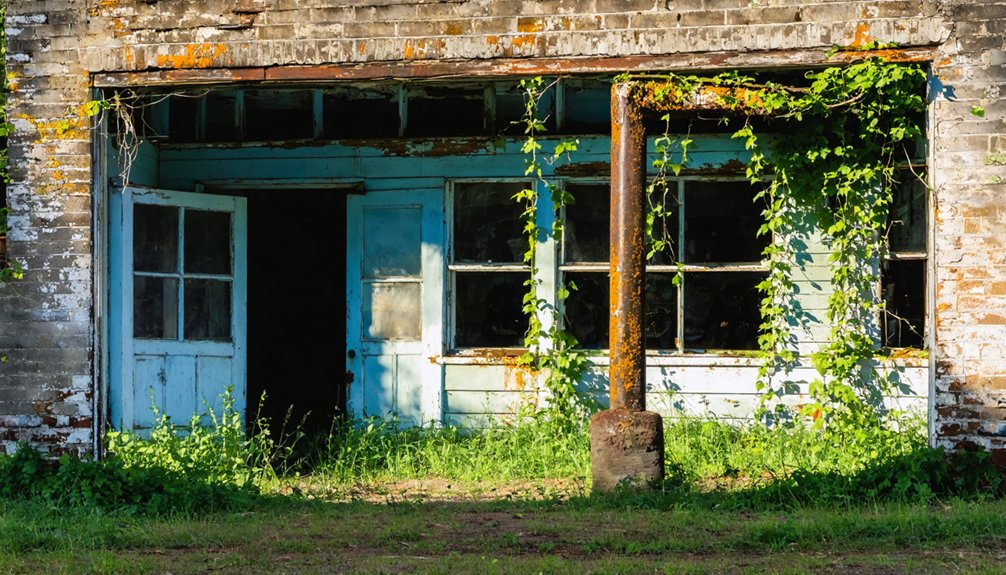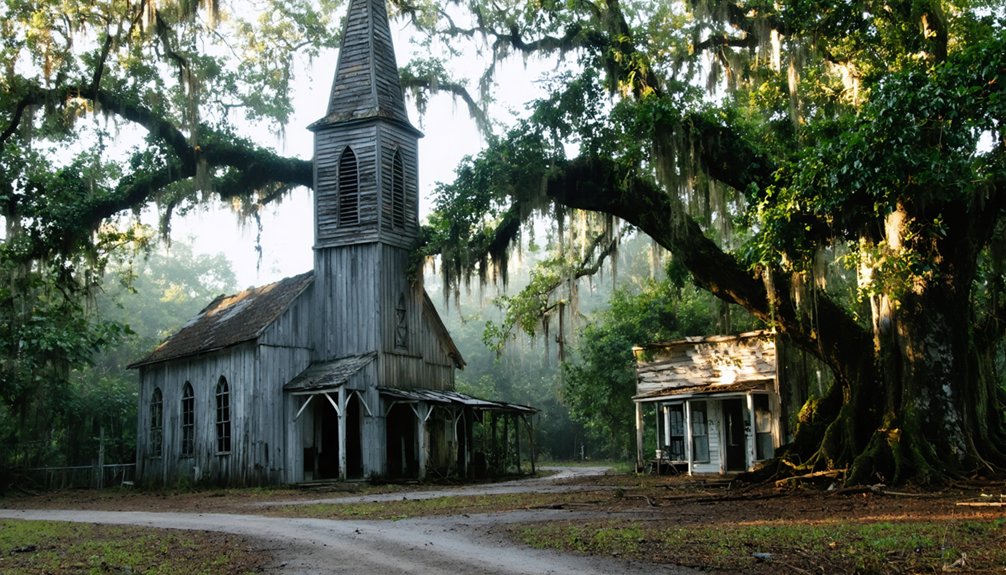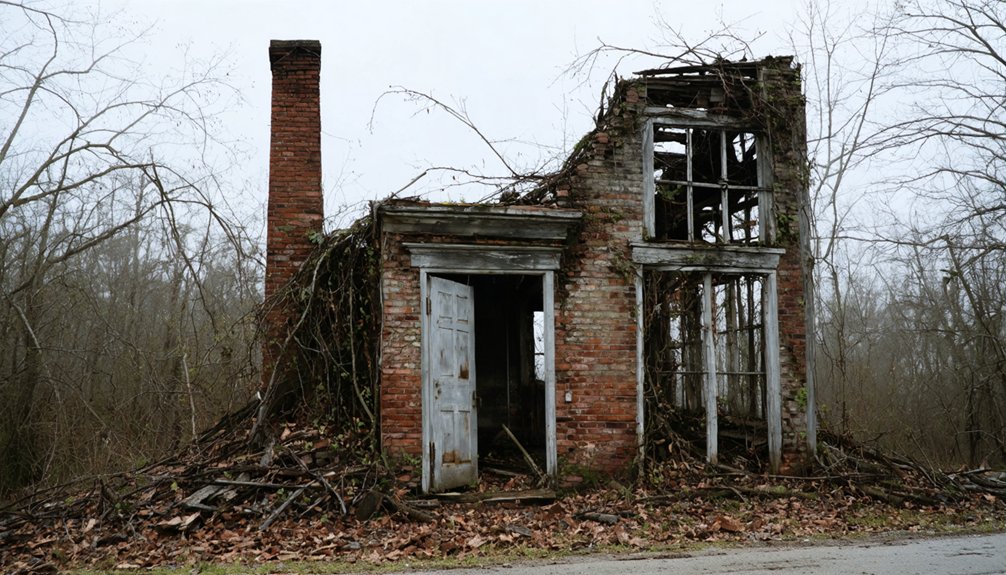You’ll find Valhermoso Springs, Alabama as a tribute to nature’s healing powers and human ambition. Originally discovered by a Native American chief seeking relief from ailments, the site transformed into a prestigious resort destination by 1818. The town flourished around its 17 mineral springs, featuring a grand three-story hotel and family cottages. While a 1950 tornado marked the end of its resort era, three accessible springs still whisper tales of its remarkable past.
Key Takeaways
- Valhermoso Springs transformed from a thriving resort destination into a ghost town after a devastating 1950 tornado destroyed its landmark hotel.
- Originally famous for its 17 healing mineral springs, the town’s decline began with natural disasters and economic challenges in the early 1900s.
- Only three accessible springs, the First Christian Church, and scattered building foundations remain as evidence of the town’s former glory.
- The 1923 fire that destroyed the business district, combined with recurring tornadoes, led to widespread business closures and population decline.
- The town’s transformation from resort destination to ghost town occurred as residents left for better opportunities following the hotel’s destruction.
The Discovery of Healing Waters
Long before white settlers arrived in Valhermoso Springs, a Native American chief made a remarkable discovery that would shape the area’s destiny. While suffering from a persistent leg sore, he found relief by applying mineral sludge from the spring runoff.
This discovery sparked generations of healing traditions centered around the springs’ therapeutic properties.
You’ll find that the area’s reputation for natural healing quickly spread, drawing both Native Americans and early settlers seeking the mineral benefits of its waters.
The popularity of the springs grew exponentially after railroad access arrived in the 1880s.
The springs’ power wasn’t just folklore – at least 17 distinct springs flowed with sulfur and mineral-rich water, each reportedly offering unique medicinal properties. Today, three springs remain accessible to visitors through a gate on County Road 34.
The mineral-rich waters flowed from 17 sacred springs, each spring a unique source of natural healing and restorative power.
These sacred waters became so renowned that by the early 1800s, health seekers regularly traveled to experience their curative effects firsthand.
From Springs to Renowned Resort
While the healing springs initially drew visitors seeking natural remedies, it wasn’t until James Manning constructed the area’s first hotel in 1818 that Valhermoso Springs began its transformation into a premier resort destination.
The resort’s transformation reached new heights under Jean Joseph Giers’ ownership in 1855.
A massive tornado destroyed the remaining hotel structure in 1950, erasing the last physical remnant of the resort’s glory days.
Visitors were drawn to the mineral springs discovered by Lancelot Chunn around 1813.
You’ll find the springs history marked by several key developments:
- A grand three-story hotel featuring a spacious top-floor ballroom
- Rows of family cottages accommodating up to six families each
- A post office established in 1834, marking growing regional importance
- A strategic rebranding from “White Sulphur Springs” to “Valhermoso Springs” in 1856
The resort’s reputation soared through national advertising campaigns in the 1870s, attracting health seekers and socialites from across the country until its operations ceased in the 1920s.
Golden Age of Southern Health Tourism
During the mid-1800s, Southern health tourism experienced unprecedented growth as wealthy Americans sought natural remedies and luxurious accommodations at mineral springs resorts.
You’d find elaborate hotels and therapeutic facilities springing up across the region, particularly in places blessed with natural springs and thermal waters. This historical pursuit of healing waters echoes the story of Ponce de Leon, who first came to Florida seeking therapeutic springs. Many visitors sought relief from widespread diseases like malaria and yellow fever that plagued the South.
The cultural significance of these health destinations went far beyond medical treatments. You’d encounter a sophisticated social scene where visitors combined their pursuit of wellness with cultural experiences and local hospitality.
Transportation improvements made it easier for you to reach these havens of health, while government support helped establish better infrastructure and public health services.
The economic impact was substantial – creating jobs, stimulating local economies, and transforming humble spring sites into prestigious retreats that drew visitors from across the nation.
Life in a Thriving 19th Century Resort Town
As visitors flocked to Valhermoso Springs in the mid-19th century, you’d find yourself immersed in a vibrant resort community centered around its renowned mineral springs.
The town’s social fabric wove together visitors seeking health benefits with local residents, creating a dynamic atmosphere of cultural exchange and community gatherings. The community thrived after Jean Joseph Giers acquired and renamed the property in 1856. Much like the Old State Bank in Decatur, the town’s structures reflected the architectural grandeur of the era.
At the heart of daily life, you’d experience:
Experience the pulsing rhythm of a community where daily life blended healing waters, spiritual gatherings, and cultural connections.
- Therapeutic treatments for various ailments at the mineral springs
- Social events and religious services at the First Christian Church
- Peaceful walks along the “Trail of Scriptures” and shaded picnic areas
- Cultural exchanges with visitors from across America and abroad
The town’s bustling post office, sawmill, and hospitality services kept the community connected and thriving, while the grand hotel stood as a symbol of the resort’s prominence in Southern health tourism.
Natural Disasters and Economic Decline
You’ll find that Valhermoso Springs’ shift from prosperity to decline largely stems from its recurring battles with devastating tornadoes, including the 1950 storm that destroyed the historic hotel.
The region’s vulnerability to natural disasters, evidenced by 161 recorded tornadoes of magnitude 2 or higher, created an unstable environment that discouraged new business investment and development. The area’s tornado risk index of 382.02 significantly exceeds both state and national averages, further deterring potential growth.
After losing its cornerstone resort attraction, the community’s tourism revenue plummeted, leaving behind a diminished economy that couldn’t recover from the combined effects of frequent storm damage and the loss of its hospitality industry. The area’s abundant medicinal waters that once drew visitors to its springs could no longer sustain the local economy on their own.
Tornado’s Devastating Impact
Throughout its history, Valhermoso Springs has endured a staggering 161 tornadoes of magnitude 2 or higher, with the most devastating strike occurring in 1950 when a powerful twister destroyed the town’s cornerstone hotel.
The tornado frequency in this region has tested community resilience, leaving lasting impacts on both infrastructure and population.
- Over 150 homes were destroyed or heavily damaged along historic tornado paths
- Mobile homes proved particularly vulnerable, resulting in numerous fatalities
- One major tornado event alone caused 130 injuries and multiple deaths
- Public utilities and transportation routes suffered repeated destruction
You’ll find the town’s decline closely tied to these natural disasters, as repeated storms ravaged businesses, churches, and gathering places.
The loss of the hotel in 1950 marked a turning point, severely impacting tourism and the health resort economy.
Economic Effects After 1923
When disaster struck Valhermoso Springs in 1923, a devastating fire ravaged the town’s business district, triggering an economic decline that would prove irreversible.
You’d have witnessed widespread business closures, including the national resort hotel that had been the town’s economic backbone. The loss of this crucial tourism hub sparked a chain reaction of economic stagnation.
The impact rippled through every sector. Sawmills near Blackwell Dr. reduced operations, while farmers struggled to find local buyers for their goods.
The town’s infrastructure crumbled as tax revenues plummeted, and public services suffered from severe budget cuts. Without the means to rebuild or attract new investment, Valhermoso Springs watched its population dwindle as residents sought opportunities elsewhere, leaving behind deteriorating buildings and abandoned businesses.
Lost Tourism Revenue Legacy
Natural disasters dealt devastating blows to Valhermoso Springs’ once-thriving tourism industry, with over 161 recorded tornadoes striking the region throughout its history.
The devastating impact on tourism infrastructure led to significant lost revenue and a rapid tourism decline, particularly after the 1920s hotel closure and its ultimate destruction by a tornado in 1950.
Key factors in the area’s economic downturn included:
- Repeated storm damage to hotels and attractions that deterred visitors
- Rising insurance and repair costs that overwhelmed local businesses
- Loss of the famous mineral springs resort that once drew national attention
- Diminished promotional efforts without an operational tourist destination
The compound effect of these disasters permanently altered the region’s economic landscape, transforming a bustling resort town into a quiet shadow of its former self.
Architectural Legacy and Lost Landmarks

Although Valhermoso Springs once boasted a nationally recognized mineral springs resort, today you’ll find few traces of its architectural grandeur. The resort’s architectural significance peaked in the early 1800s, featuring Southern-style hotels and health facilities that blended seamlessly with the natural springs landscape.
You can imagine the original resort’s community heritage through historic accounts describing grand porches and communal spaces where visitors gathered for healing and socializing. The main hotel, which anchored the town’s identity until 1923, incorporated local materials and construction techniques typical of early Alabama resorts.
Tragically, a 1950 tornado destroyed this landmark and most associated structures, leaving only fragments of the town’s built history. Today, only the First Christian Church property and a historical marker stand as reminders of this once-thriving resort town.
Historical Preservation Efforts
Despite the physical loss of most historic structures, preservation efforts in Valhermoso Springs center around a state-recognized historical marker and dedicated local organizations.
Local heritage preservation initiatives focus on documenting and sharing the town’s rich history as a mineral springs resort destination.
- First Christian Church maintains a “Trail of Scriptures” and picnic areas, serving as an informal preservation site.
- Historical societies collect photographs, maps, and documents for public archives.
- Local churches act as custodians of historical remnants, including the old sawmill slab.
- Community groups provide educational outreach about the town’s cultural legacy.
You’ll find detailed accounts of the resort’s heyday in James F. Sulzby’s writings and period newspapers, while community involvement through churches and historical societies guarantees the ghost town’s story lives on through organized commemoration efforts.
Modern Day Glimpses of Past Glory

When you visit Valhermoso Springs today, you’ll find the enduring First Christian Church property with its “Trail of Scriptures” and shaded picnic areas serving as tangible links to the community’s religious past.
The mineral springs that made this area famous still flow about 50 yards north of Highway 36, offering a glimpse of what drew visitors here two centuries ago.
While the historic resort hotel was lost to a 1950 tornado, you can still examine its old foundations and other remaining slabs near Blackwell Drive, close to the Baptist and Christian churches that anchor the present-day community.
Surviving Historic Church Traces
Traces of Valhermoso Springs’ religious heritage remain visible through the enduring presence of its historic churches. When you visit today, you’ll find a rich tapestry of historic church architecture that tells the story of this once-thriving community’s spiritual foundation.
- The Valhermoso Springs Holiness Church, established in 1922, stands as a symbol of the area’s deep religious roots, beginning with services in homes and yards.
- The original church site, located on Bro. Chum McCutcheon’s property, marks where the community’s religious impact first took hold.
- You can still find remnants of the community’s focus on Holy Ghost worship and miraculous healings in local church traditions.
- The Valhermoso Christian Church continues to welcome visitors with its “Trail of Scriptures” and picnic grounds, preserving the area’s spiritual heritage.
Natural Spring Site Today
Beyond the spiritual landmarks of Valhermoso Springs lies the site of its once-famous mineral springs, the natural wonder that first put this ghost town on the map.
Today, you’ll find these springs nestled in Morgan County’s rolling landscape, marked by a historical marker that recalls their former glory. While you can’t check into the grand resort hotel that once drew visitors nationwide, you can still appreciate the mineral richness that made this site a renowned health destination until 1923.
The springs remain a representation of the area’s historical significance, surrounded by native Alabama flora and fauna.
Though the bustling resort days are long gone, you’ll discover the same natural features that caught Lancelot Chunn’s eye in 1813, preserved within the quiet countryside along Highway 36.
Old Hotel Location Remnants
Standing at the historical marker along State Highway 36, you’ll find yourself at the former site of Valhermoso Springs’ grand hotel, though little remains of its once-magnificent structure.
The 1950 tornado destroyed most visible traces of this nationally renowned resort, but exploration adventures in the early 1990s revealed fascinating hotel remains:
- Dilapidated main building with broken windows and weathered walls
- Swimming pool area with deteriorating bathhouses and rusted ladders
- Dancing pavilion structure showing decades of abandonment
- Foundation slabs marking where auxiliary buildings once stood
Today, modern churches and developments surround this historical site, but you can still sense echoes of its prestigious past.
While most physical evidence has vanished, the area’s rich history lives on through local stories and documented photographs of its final ruins.
Frequently Asked Questions
What Indigenous Tribes Originally Inhabited the Valhermoso Springs Area?
Like ancient roots intertwined beneath soil, you’ll find the Creek (Muskogee) were the primary Native American tribes in your area, while Cherokee also maintained significant historical presence around Valhermoso Springs’ lands.
Are the Mineral Springs Still Accessible to the Public Today?
You won’t find public facilities or mineral access at these springs today. While the historical site exists, there’s no maintained infrastructure or official access point for visitors to experience the waters.
What Was the Average Daily Rate at the Resort Hotel?
You won’t find exact resort pricing records from Valhermoso Springs’ heyday, though its upscale hotel amenities and affluent clientele suggest it catered to middle and upper-class guests with means.
Did Any Famous Historical Figures Visit Valhermoso Springs During Its Heyday?
Ever wonder about the resort’s guest list? While the springs held historical significance as a health retreat, there’s no verified evidence of any famous visitors during its peak years as a destination.
What Chemical Compounds Were Found in the Mineral Spring Waters?
You’ll find typical mineral composition included carbonates, sulfates, iron, and sulfur compounds, though no direct chemical analysis exists. Regional springs suggest therapeutic benefits came from calcium-bicarbonate and dissolved gases.
References
- https://alabamayesterdays.blogspot.com/2015/05/valhermoso-springs.html
- https://digitalalabama.com/alabama-ghost-towns/alabama-ghost-towns/9449
- https://freepages.history.rootsweb.com/~gtusa/usa/al.htm
- https://en.wikipedia.org/wiki/Valhermoso_Springs
- https://en.wikipedia.org/wiki/List_of_ghost_towns_in_Alabama
- https://alabamasfrontporches.org/healing-springs/
- https://www.youtube.com/watch?v=aOoG4XbRfpk
- https://alabamamineralsprings.com/history-of-alabama-mineral-springs/
- https://www.ruralswalabama.org/attraction/healing-springs-at-millry-al/
- https://www.morgancountysheriffal.gov/history-of-the-sheriffs-office



